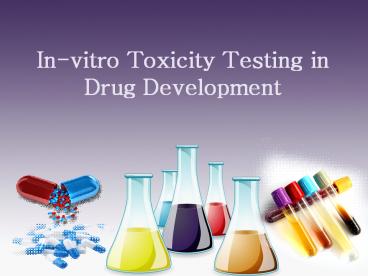In-vitro Toxicity Testing - PowerPoint PPT Presentation
Title:
In-vitro Toxicity Testing
Description:
In-vitro Toxicity Testing in Drug Development – PowerPoint PPT presentation
Number of Views:493
Title: In-vitro Toxicity Testing
1
In-vitro Toxicity Testing in Drug Development
2
Toxicity Testing
- Before submitting an IND application, the
concerned drug must go through a comprehensive
series of in-vitro and in-vivo toxicity testing
to ensure maximum safety in clinical trials. - Considering the ethical issues and the cost of
in-vivo animal tests, the pharmaceutical industry
now relies more on in-vitro methods for toxicity
testing in the drug development phase.
3
Here, we answer the common questions regarding
the in-vitro toxicity testing in drug development.
4
1) What is the right time to screen for toxicity
in drug discovery and development project?
- Screening for toxicity should start as early as
possible to reveal inappropriate drugs early. - This helps to eliminate such drugs from the drug
development process timely and saves resources.
5
2) What are the most common types of toxicity
observed in drug development?
- Hepatotoxicity (toxic effects on the liver) and
cardiotoxicity (toxic effects on the heart) are
the most severe problems encountered in drug
development and the major reason for drug
withdrawals. - In addition, possible mutagenesis (genotoxicity)
caused by the concerned drug candidates is also
observed frequently.
6
3) What types of assays are used for liver
toxicity testing?
- Liver toxicity or Drug-induced liver injury
(DILI) can occur through several mechanisms like
direct cell injury, mitochondrial injury, etc. To
study direct cell toxicity, you can use membrane
integrity assay (LDH release). - The viability of the cells can be assessed by
measuring cell metabolic activity using MTT assay
or by measuring the ATP levels of the cells.
7
4) How do you screen for cardiotoxicity?
- The severe cardiotoxic effect is mainly caused by
the blockage of a potassium ion channel, hERG
(human Ether-à-go-go-related gene) which prolongs
the QT interval. - Thus, cardiotoxic effects can be screened by
testing the hERG blockage. They use HTS 384-plate
fluorescence polarisation assay for this purpose
as it is cost-effective and gives quicker results
than the traditional patch-clamp assay.
8
5) Why should you screen for genotoxicity?
- Genotoxic compounds can cause mutations in DNA
and predispose to cancer and reproductive
problems. Therefore, its crucial to screen for
genotoxicity. - As per the regulatory guidelines, the standard
tests for genotoxicity screening include
bacterial reverse mutation test (AMES) and a
mammalian genotoxicity assay.
9
6) What are the other toxicity tests to consider
in drug development?
- Based on the properties of the investigational
drug, other screening assays to consider are
reactive metabolite formation and time-dependent
CYP inhibition or transporter inhibition. - 3D cell models are useful o screen for
metabolism-dependent toxicity or delayed toxicity
as they allow long-term incubation with the
metabolically active cells.
10
7) What are the requirements of the authorities
for toxicity studies?
The safety of a new drug candidate is very
important. Therefore, toxicity testing is
strictly controlled and has to be performed in
animals and in GLP (Good Laboratory Practice)
conditions to select a safe starting dose for the
clinical trial in humans. Non-GLP screening
assays are not accepted any more.
11
- Email ID project_at_cognibrain.com
- Phone 044-49595223
- Visit us https//www.cognibrain.com/































